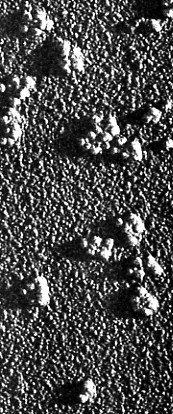They translate the information encoded in messenger RNA (mRNA) into a polypeptide.
| Link to a description of the process |
 Ribosomes are
Ribosomes are
Then, before these proteins reach their final destinations, they undergo a series of processing steps in the Golgi apparatus.
| Link to discussion of Protein Kinesis: the pathways taken by proteins synthesized on the endoplasmic reticulum. |
| Link to discussion of the evolution of mitochondria. |
This table gives some of the data. (S values are the sedimentation coefficient: a measure of the rate at which the particles are spun down in the ultracentrifuge. S values are not additive. nts = nucleotides.)
| Comparison of Ribosome Structure in Bacteria, Eukaryotes, and Human Mitochondria | ||||
|---|---|---|---|---|
| Bacterial (70S) | Eukaryotic (80S) | Mitochondrial (55S) | ||
| Large Subunit | 50S | 60S | 39S | |
| rRNAs (1 of each) |
23S (2904 nts) | 28S (4700 nts) | 16S (1560 nts) | |
| 5S (120 nts) | 5S (120 nts) | |||
| 5.8S (160 nts) | ||||
| Proteins | 33 | 47 | 50 | |
| Small Subunit | 30S | 40S | 28S | |
| rRNA | 16S (1542 nts) | 18S (1900 nts) | 12S (950 nts) | |
| Proteins | 22 | 33 | 30 | |
But despite these differences, the basic operations of bacterial, eukaryotic, and mitochondrial ribosomes are very similar.
| Welcome&Next Search |